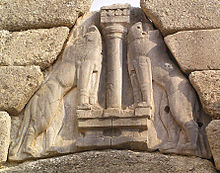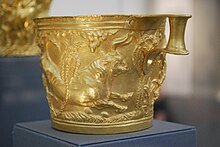Mycenaean art

The Mycenaean art owes its name to Heinrich Schliemann's discoveries of Mycenaean culture in Mycenae and some other sites on the Greek mainland. From the late 3rd millennium BC onwards BC ( Early Helladic III) Indo-Europeans immigrated to mainland Greece. They mingled with the indigenous pre-Indo-European population and the early Greek language and the Middle Helladic cultures gradually developed . These came under the influence of the superior Minoan culture of the island of Crete from the late 17th century . The merging of Middle Helladic traditions with the cultural achievements of the Cretans developed - in parts of the Peloponnese as early as 1600 - the Mycenaean culture and the Mycenaean art.
General
Wall painting has a special place in Mycenaean art. It is heavily influenced by the Minoan. The old "natural religion" lives on in the Mycenaean culture and there are no legends here either . The hero cult emerges clearly . The Mycenaean castles are fortified and dominated by the throne room ( megaron ) with its portico. Huge ruins of castles and cupola tombs bear witness to a monumental character.
Among the Mycenaean works of art, the dome tombs and castles are most likely to testify to a piety of their own, in which Greek insight into the greatness and conditionality of man spreads.
Wall painting
Remnants of wall paintings were found in many places on mainland Greece. The mural painting has very likely been taken over from Crete and the earliest examples may even have been done by artists who came from the island. Earlier paintings are therefore based on the Minoan style, while a distinct style can only be clearly recognized over time. There are also differences in motifs. Hunting and fighting scenes play an important role in Mycenaean painting. Large-scale painting of floors was also popular, something that is less common in Crete. It is not entirely certain which technique was used in the paintings. At first it was assumed that these were pure frescoes in which the paint was still applied to the wet plaster. However, recent studies indicate that details were also applied to the dry plaster, so that one can speak of a mixture of fresco and secco painting .
The oldest remains of wall paintings can be found in Mycenae itself and date to the late Helladic I or Late Helladic IIa epoch and thus shortly before 1450 BC. There are some small fragments. The dating was based on the pottery found here. Other early paintings also come from Mycenae and are closely related to paintings from Knossos . There are women, a shrine and bull jumpers. Popular themes in Mycenaean wall paintings are processions, a motif that may have come from Egypt. One of the earliest examples comes from Thebes . Women are depicted carrying flowers and objects carrying small chests. The procession may be directed towards a sanctuary or shrine, but nothing has survived. The head of a woman comes from Mycenae, probably around 1350 BC. BC and is considered a masterpiece. The profile is skillfully drawn. Eyes and ears are reproduced naturalistically. The chest is painted frontally.
Significant remains of wall paintings were found in the palace of Pylos. The entrance gate was decorated with rows of tribute-bringers. The megaron, the main hall of the palace, was painted with bulls, lions and deer. There were also pictures of griffins. A small scene shows two people at a banquet who found themselves next to a large figure of a lyre player. The interpretation of these representations is difficult, they probably had more of a religious meaning. Other representations in the palace show hunting and war scenes.
Later paintings (Helladisch IIIB, approx. 1250 BC) often appear coarser than the earlier paintings. The drawing often looks careless. The figures are mostly drawn with thick black paint. An example is the image of a goddess from the citadel of Mycenae. The figure is drawn with black outlines, with few interior drawings. Compared to earlier representations, the picture looks rather clumsy.
plastic
In contrast to other advanced cultures, plastic only played a subordinate role. The most famous work of Mycenaean sculpture is certainly the lion gate in Mycenae . Two upright lions are shown here to the right and left of a column. The relief is strongly modeled. The contours and details of the animal bodies are skillfully worked. The work probably dates to around 1200 BC. Chr.
Other reliefs from Mycenae, on the other hand, are far less artistically designed. Various steles were found near the grave complex in Mycenae. They are decorated with flat relief. There are spiral patterns and depictions of hunting and war. The figures seem rather clumsy. Overall, the artists seem to have endeavored to decorate every free space ( horror vacui ).
In contrast, high-quality works of Mycenaean sculpture can be found in cabaret. There are outstanding elf carvings from various sites. Again from Mycenae a group of two women with a child, 8 cm high, came from. The work is cut from ivory. The two women wear baggy dresses. They sit on the floor while a child plays in front of them. A work of comparable quality was found on Delos. Here a soldier is shown lying on a shield. A round box comes from Athens on the outside of which there are griffins attacking a deer. Here, too, the figures are skillfully cut into the material. In all of these works the figures are reproduced naturalistically.
Goldsmith work
Mycenaean artists brought goldsmithing to a special level; gold vessels, jewelry and weapons are to be mentioned here. Since these types of objects are those that were easily transportable, it is often uncertain whether they are Minoan or Mycenaean works. Golden vessels are known from various grave complexes. Some of them are decorated with a relief. Some gold cups come from Mycenae. One of them shows a row of rosettes, another shows a running lion. Two golden cups come from an undisturbed Tholos grave of Vaphio near Sparta . They demonstrate the skills of Mycenaean goldsmiths. On the cups are found stamped into the gold sheet. One cup (see picture) shows three running bulls in a rocky landscape. One of the bulls is trapped and tied between two olive trees. Another bull flees behind a palm tree, while the third tramples a man and is attacked by another man. The other cup appears to show three stages in capturing a bull. A bull stands alone in a pasture, in the second scene he plays with a cow, while in the third scene he is tied to the leg by a man. A special masterpiece is a silver vase with gold plating in the shape of a bull's head.
Ceramics
Main article: Mycenaean ceramics

Since the late phase of the Middle Helladic period (approx. 17th century BC), painted ceramic vessels have been found on the Greek mainland, which are initially based on Minoan models. The vessel shapes of the early Mycenaean ceramics can also be derived partly from Crete, but partly also from the Middle Helladic Miny ceramic . The earliest examples appeared in Laconia and the Argolidae. At the same time, ceramic styles typical of the Middle Helladic, such as gray, so-called Miny ceramics or matt-painted ceramics , continued to be produced in many other regions . Little by little, the Mycenaean ceramics spread throughout the Peloponnese as well as in Central Greece and replaced the Middle Helladic styles. Vegetable motifs are adopted from Minoan art, which are painted in dark color on the light clay. The plants are usually so stylized that it is usually not possible to identify them botanically. In addition to the floral motifs, there are also figurative representations, especially chariots, soldiers, but also animals such as bulls or birds. Here, too, the figures are strongly stylized and applied in one color to a light background. These representations are perhaps inspired by the wall paintings that were made at the same time.
literature
- Sinclair Hood: The Arts in Prehistoric Greece . Yale 1978, ISBN 0-300-05287-1 .
Individual evidence
- ^ Hood: The Arts in Prehistoric Greece , p. 83.
- ^ Hood: The Arts in Prehistoric Greece , p. 77.
- ^ Hood: The Arts in Prehistoric Greece , p. 79.
- ^ Hood: The Arts in Prehistoric Greece , p. 80.
- ↑ Hood: The Arts in Prehistoric Greece , pp. 81-82.
- ^ Hood: The Arts in Prehistoric Greece , p. 159.
- ↑ Hood: The Arts in Prehistoric Greece , pp. 166-67.
- ↑ Hood: The Arts in Prehistoric Greece , pp. 41–45.




